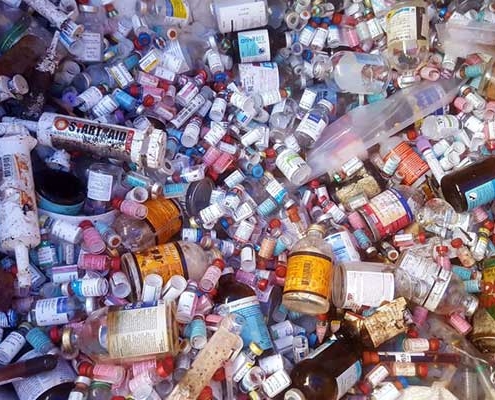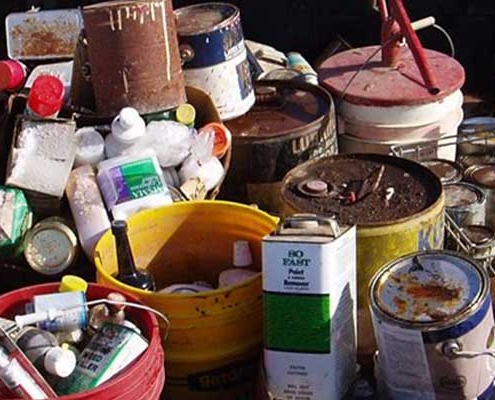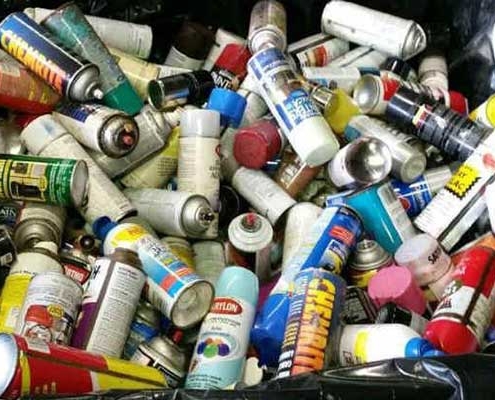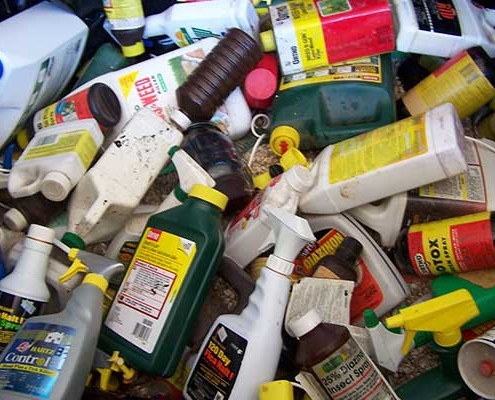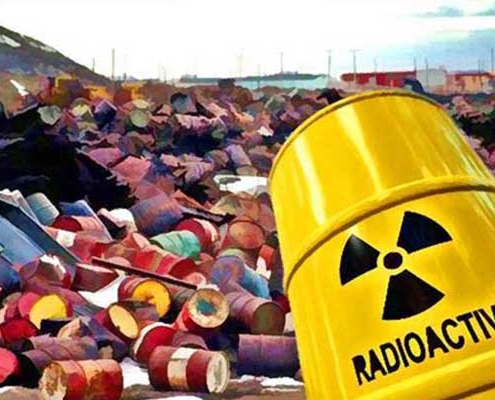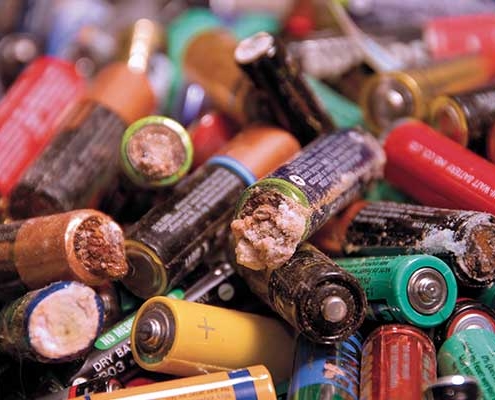Hazardous waste treatment
Introduction
Hazardous waste: refers to the waste with hazardous characteristics which is listed in the national hazardous waste list or identified according to the national hazardous waste identification standards and methods.
Types of hazardous waste
The list of hazardous wastes includes: medical wastes, pharmaceutical wastes, waste drugs, pesticide wastes, wood preservative wastes, waste organic solvents and wastes containing organic solvents, heat treatment cyanide wastes, waste mineral oils and wastes containing mineral oils, oil-water, hydrocarbon/water mixtures or emulsifiers, polychlorinated (brominated) biphenyl wastes, distillation residues, dyes and paint wastes. Organic Resin Waste, New Chemical Waste, Explosive Waste, Photosensitive Material Waste, Surface Treatment Waste, Incineration Waste, Carbonyl Compound Waste, Beryllium Waste, Chromium Waste, Copper Waste, Zinc Waste, Arsenic Waste, Selenium Waste, Cadmium Waste, Antimony Waste, Tellurium Waste, Mercury Waste, Thallium Waste, Lead Waste, Inorganic Waste Fluoride waste, inorganic cyanide waste, waste acid, waste alkali, asbestos waste, organic phosphorus compound waste, organic cyanide waste, phenol waste, phenol waste, ether waste, organic halide waste, nickel waste, barium waste, non-ferrous metal smelting waste, other waste, waste catalyst and other 50 categories.
Impact of hazardous waste
Destroy the ecological environment
Under the long-term infiltration and diffusion of rainwater and groundwater, hazardous wastes discharged and stored at will will pollute water and soil and reduce the environmental function level of the region.
Impact on human health
Hazardous wastes may cause poisoning, or cause combustion, explosion and other dangerous events through ingestion, inhalation, skin absorption and eye contact;Long-term hazards include long-term poisoning, carcinogenesis, teratogenicity and mutagenesis caused by repeated exposure.
Environmental protection
The pollution of air, water and soil caused by the non-treatment or non-standard treatment of hazardous waste will also become the bottleneck restricting economic activities.
Hazardous waste treatment technology
Comprehensive utilization (resourced)
In theory, comprehensive utilization technologies can be divided into energy replacement technologies, physical and chemical treatment technologies, material separation and recovery technologies, material recovery and land reduction technologies. At present, the comprehensive utilization of hazardous wastes is mainly concentrated in the recycling of metals, waste organic solvents, waste acids and alkalis, waste oil, and electronic waste. The main uses are physical and chemical treatment technologies and material separation and recovery technologies. Typical methods include cleaning, drying, crushing, sorting, neutralization, flocculation, precipitation, redox, crystallization, sintering, pyrolysis, distillation, adsorption, biological treatment, magnetic separation / electric separation and other process means.
The advantages of comprehensive utilization of hazardous wastes are resource utilization and resource recycling. However, the price of resource-based products fluctuates greatly, the profit margin is not high, and the comprehensive utilization technology is relatively rough, and secondary pollution may be caused during the regeneration process.
Pre-processing
Hazardous waste is corrosive, toxic, flammable, reactive or infectious. Pretreatment refers to the use of physical, chemical, biological, solidification and other technologies to detoxify and reduce hazardous wastes that cannot be comprehensively utilized.
(1) Physical processing
The structure of hazardous waste is changed by concentration or phase change to make it convenient for transportation, storage, utilization or further disposal. Physical treatment methods mainly include adsorption, compaction, crushing, separation, extraction, solid-liquid separation, dialysis, cooling crystallization, reverse osmosis, air stripping and so on. After the physical treatment of hazardous waste, the volume of hazardous waste can be greatly reduced, and it is suitable for the treatment of wastes such as sludge and industrial residues with high moisture content.
(2) Chemical treatment
The chemical method is used to destroy the harmful components in the hazardous waste. The purpose is to change the chemical properties of the treatment substance, reduce its harmfulness, and transform it into a form suitable for further processing and disposal. Chemical treatment is the main pretreatment method before hazardous waste enters the final disposal stage. It is generally used to treat inorganic waste. Such as waste acid and alkali, waste liquid containing heavy metals, waste liquid containing cyanide, emulsified oil, etc. Common treatment methods include acid-base neutralization, redox, flocculation and sedimentation.
(3) Biological treatment
The metabolism of microorganisms, animals and plants is used to degrade the organic substances contained in hazardous waste. It is mainly limited to the treatment of organic waste liquid and wastewater. Compared with other pre-treatment methods, biological treatment can reduce the waste of hazardous waste while achieving resource recovery to a certain extent, which is mainly reflected in the production of biogas and fertilizer. The disadvantage of biological treatment is that the treatment cycle is long and the stability is poor. There is a risk that pollutants will diffuse into the environmental soil and water during the treatment. Detailed records and control management of the process are required.
(4) Curing / stabilizing treatment
Physical or chemical methods are used to fix or encapsulate hazardous waste in a dense inert solid substrate. The process of stabilization is achieved. The migration rate of pollutants in the waste is minimized. The solidification / stabilization of hazardous waste is generally used as a pre-treatment step before safe landfill disposal. Solidification / stabilization treatment technology is mainly used to treat wastes that are not suitable for incineration or inorganic treatment. Such as radioactive waste, concentrated liquid, sludge containing heavy metals, incineration fly ash and slag, etc. Common treatment methods are cement curing, asphalt curing, glass curing, plastic curing, organic polymer curing, etc.
Landfill
At present, domestic and foreign generally believe that safe landfill technology is the method of final disposal of hazardous waste. For hazardous wastes that have undergone pretreatment processes such as dehydration, neutralization, composting, solidification and stabilization. In order to control, reduce and eliminate its hazards, safe landfill is the final disposal procedure of hazardous waste.
The core of a hazardous waste landfill is an anti-seepage system. The main function is to block the hydraulic connection of the waste with the external environment. That is, measures to prevent the leachate generated by the waste from contaminating groundwater and other surrounding water bodies. Common anti-seepage systems use double artificial linings, from bottom to top: base layer, groundwater drainage layer, compacted clay lining layer, high-density polyethylene film (HDPE), protective layer on the membrane, and leachate secondary Drainage layer, high-density polyethylene film (HDPE), protective layer on the membrane, primary drainage layer of leachate, geotextile, hazardous waste.
There are also some shortcomings in the safe landfill method. The main reason is that the leachate produced by hazardous waste has the risk of leaking and contaminating the soil and groundwater. In addition, the landfill method occupies a lot of valuable land resources.
Heat treatment
The heat treatment of hazardous waste is a comprehensive process of pyrolysis and deep oxidation. The flammable hazardous waste is completely oxidized and decomposed to achieve the purpose of greatly reducing the volume and completely removing toxicity.
(1) Incineration disposal
Incineration treatment is the thermal oxidation treatment of combustible hazardous waste at high temperature (f850 ~ 1200 ℃). Under the condition of complete combustion, the removal rate of organic matter can reach 99.99%, which is a relatively complete and thorough method of decomposing and destroying waste. In addition, incineration can greatly reduce the volume of waste. A small amount of ash produced by incineration can be sent to a safe landfill site, which greatly reduces the amount of landfill waste. There are many types of incinerators for waste incineration, including grate incinerators, liquid jet incinerators, multi-stage incinerators, rotary kiln incinerators, and fluidized bed incinerators. Among them, rotary kiln incinerators are hazardous waste incinerators. Mainstream furnace type.
Incineration treatment technology is currently the most widely used technology for hazardous waste disposal at home and abroad. The technology is highly adaptable. It can handle any solid, liquid, gaseous combustible hazardous waste except radioactive waste and explosive waste; it can also provide heat energy and recover heavy metals. Wait. The disadvantages of incineration treatment technology are high investment and operating costs, and long investment recovery period: incineration will generate a lot of acid gases and dioxins. There is a risk of secondary pollution.
(2) Cooperative disposal of cement kiln
The co-processing of hazardous waste by a cement kiln refers to putting into the cement kiln or cement mill hazardous waste that meets or meets the requirements for entering the kiln after pretreatment. At the same time as clinker or cement production. The process of achieving the harmless disposal of hazardous waste. The developed countries such as Europe, the United States, and Japan have used cement kilns to co-process solid waste for more than 30 years. The technology is mature and the advantages are obvious:
From the project implementation level:
1. The project site selection and approval is faster than the new incineration project, saving a lot of time;
2. Has the advantages of less investment and short construction period. The investment in cement kiln co-processing hazardous waste is about 1/3 to 1/5 of the investment in professional incinerators;
3. Low operating costs. And no waste residue needs landfill disposal.
From a technical perspective:
1. The temperature in the kiln is high, which can reach 1450 ℃, and the residence time is long. It is necessary to ensure that the harmful components are completely destroyed;
2. The scale of co-processing hazardous wastes in cement kilns is large and has obvious capacity advantages;
3. Alkaline / reducing environment in the kiln, inhibit the generation of acid gases and dioxins. At the same time, the heavy metals in the waste can be solidified at high temperatures and stably retained in the clinker minerals.
Although the cement kiln collaborative disposal method has obvious advantages, the restricted conditions are also relatively prominent:
1. Affected by national macro-planning and industrial policies, the selection and approval of co-processing projects are limited;
2. In order to ensure cement quality and safe production, the content of heavy metals, fluorine, chlorine, sulfur and other elements in hazardous wastes allowed to enter the kiln must be strictly controlled, so the types of wastes for co-processing are restricted to a certain extent.
(3) Plasma disposal
Plasma treatment of hazardous waste technology uses high-temperature thermal plasma to quickly decompose and destroy hazardous waste. Organic matter is pyrolyzed into flammable small molecular substances, and inorganic substances are melted at high temperature to generate vitreous residues. Plasma melting furnaces are divided into plasma arc melting furnaces and plasma torch melting furnaces.
They were first applied to the treatment of biochemical weapons and highly toxic and hazardous waste. It is recommended for the disposal of hazardous wastes with high toxicity and stable chemical properties. They can persist in the environment for a long time, especially suitable for the disposal of fly ash after garbage incineration, crushed electronic waste, liquid or gaseous toxic hazardous waste, etc., which have complicated forms. Wastes that are not easily broken into small particles have poor adaptability.
The advantages of the plasma treatment technology are safety, high efficiency, no secondary pollution, and wider applicability, achieving the greatest degree of reduction and harmlessness. The disadvantage is that the plasma melting furnace uses electricity as an energy source, and the economic cost is high.
(4) Other technologies
In addition to the three mainstream heat treatment technologies mentioned above, the heat treatment technologies for hazardous wastes also include pyrolysis incineration technology, electrolytic oxidation technology, wet air oxidation technology, supercritical water oxidation treatment technology, etc. that are gradually being phased out and replaced.

